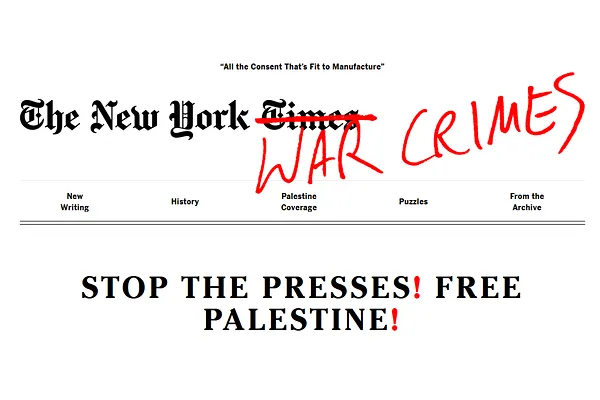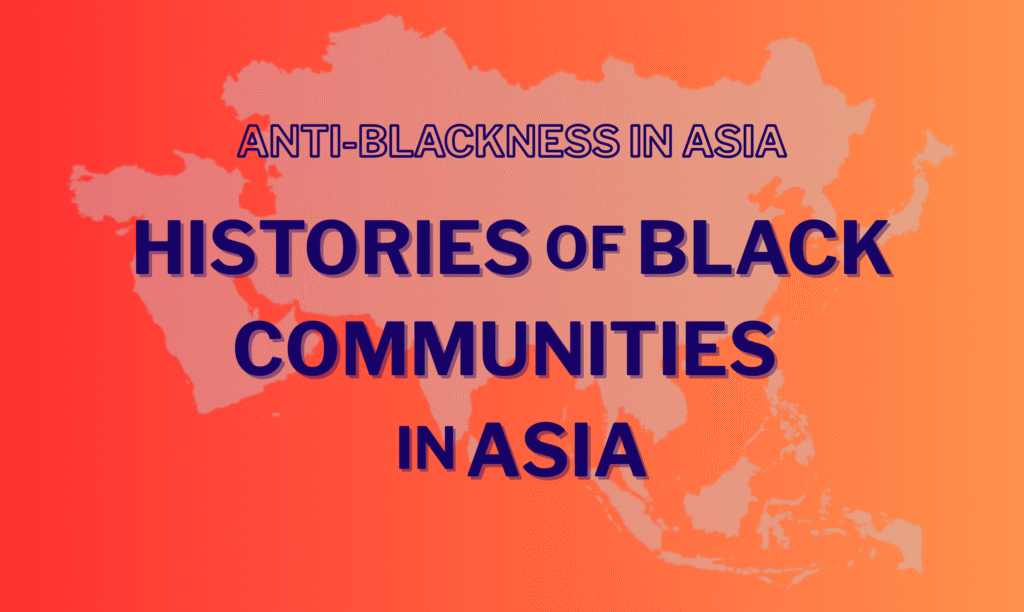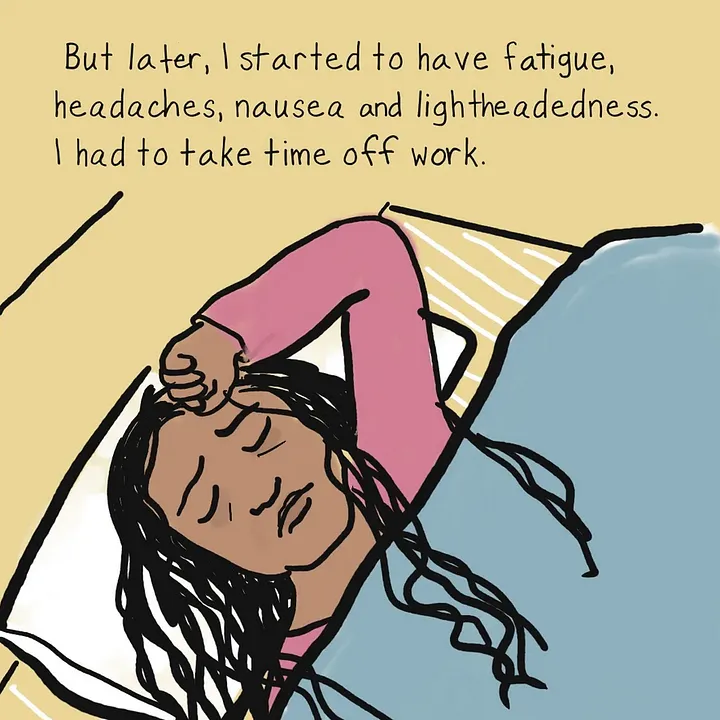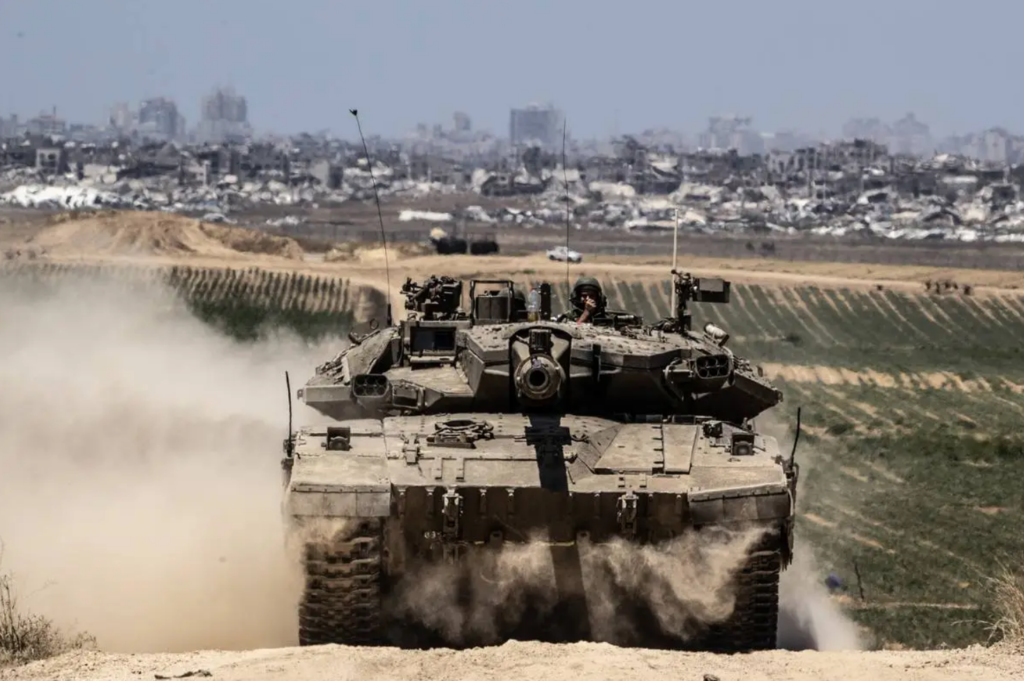Part V in my series on eco-colonialism, climate injustice, and genocide in Palestine
As long as Palestinians have been under threat of Zionism and settler colonialism, there has been Palestinian resistance. As historian Vijay Prasad has pointed out, what Palestinians have done to show that their liberation is key to all anti-colonial struggles is remarkable, given their relatively small population on a global scale. This is not to say that Palestinians are in any way undeserving of worldwide attention, nor to diminish the atrocities they’ve experienced for almost a hundred years. Rather, I mean to uplift how powerful Palestinian resistance is across the globe.
This is the last post in my series on eco-colonialism, climate injustice, and genocide in Palestine. Today, I’ll be focusing on how Palestinian resistance shows up in terms of environmental and climate justice. Thanks so much to Stephanie Noren, James Williams, Emily Pinckney, Brittney Miller, and Neiko Alvarado for your collaboration and invaluable feedback on this whole series – your support has kept me writing.
When the Tree rises up, the branches
shall flourish green and fresh in the sun
the laughter of the Tree shall leaf
beneath the sun
and birds shall return
Undoubtedly, the birds shall return.
The birds shall return.
from “The Deluge and the Tree” by Fadwa Tuqan, translated from Arabic by Naomi Shihab Nye with help from Salma Khadra Jayyusi
Eco-sumud, a’wna, and a’wda
The concept of sumud, which means “steadfastness” in Arabic, is a crucial part of Palestinian resistance. After Israel’s 1967 invasion and occupation of Gaza and the West Bank, sumud came to represent Palestinians’ resilience in surviving colonization and military occupation, not only through active resistance efforts and but also through their everyday survival, as well as their continued hope and desire to return to their homes in a free Palestine.
In Dismantling Green Colonialism: Energy and Climate Justice in the Arab Region, climate researcher and activist Manal Shqair introduces the concept of “eco-sumud”:
“Eco-sumud… combines Palestinians’ everyday practices of steadfastness with environmentally friendly ways of maintaining a strong attachment to the land of Palestine. It covers the indigenous land-based knowledge, cultural values, tactics and tools Palestinians employ to fight back against the violent Israeli settler colonial disruption of their sustainable relationship with the land. The concept of eco-sumud is premised on the understanding that the only sustainable solutions to the ecological and climate crises are those that support the quest of the Palestinian people for a just agricultural and energy transition.” (pp. 79-80)

Political scientist Ghada Sasa also relates environmental justice in Palestine to the ideas of a’wna (“collaboration”) and a’wda (“return”). A’wna encompasses solidarity not only between all peoples but also non-humans. This is not to say that animals or plants should be prioritized over humans – an idea that is often connected to environmental racism, and can be used to unjustly essentialize Indigenous people as inherently connected to “nature” – but that Palestinians, while still prioritizing their communities, see that non-humans are still deserving of care and respect, and that harm to them can mean harm to people as well. Meanwhile, a’wda encompasses the struggle towards liberation of all people, but also brings to mind the Palestinian Right to Return specifically.
The land and the people remember
The Palestinian Right to Return to the land their families lived on before the 1948 Nakba, which is enshrined in international law, is central to Palestinian liberation movements. It is also eminently practicable: as Nakba expert and engineer Salman Abu-Sitta demonstrates, since 88% of Jewish Israelis currently live on only 12% of the land in Israel – primarily in urban areas – most Palestinians, who are refugees from rural villages, can easily return to their homes without displacing anyone.
Palestinians keep the vision of return to their land alive through remembering. Anthropologist Ruba Salih and international relations scholar Olaf Corry discuss how Palestinian refugee camps are made to be sites of eco-resilience:
“Walking around camps, one can bump into the unexpected intensity of green, yellow and orange colours of fruit trees, popping out of hindered yards and breaking the seamless grey of the cement and black of the open air electric wires. Occasionally, the surprising presence of goats interrupt the weirdly monotonous soundscape of the camp. Elderly refugees keenly insist on reproducing the rhythms, smells, and tastes that were left behind decades ago, but also affect a present-actuality with their production of milk and cheese for the family. This reproduction of a past human–nature entanglement in the camp should not be read merely through the trope of nostalgia for a rural lost past and livelihood. Crucially, for the argument of this article, it rather antagonises erasure and disappearance in the present by imposing, and bringing to life, novel enmeshments ” (p. 392)
Even the land that is currently colonized by Israel exhibits a kind of unruliness: cacti, olive trees, and other native plants often find a way to grow and survive through the rubble destroyed villages and homes.
Agro-resistance and food sovereignty
Palestinians must constantly fight to defend the land that they currently live and work on, including through agricultural resistance. Israel works to violently interrupt Palestinian agriculture, both to steal land for illegal settlements and exert power over Palestinians, and also to keep demand for imported Israeli goods high among Palestinian customers. The West Bank, in fact, is one of the most import-dependent parts of the world. J.L. Pedersen argues that these patterns constitute a “slow violence”, and that Palestinian farmers’ efforts to achieve food sovereignty – control over their food systems – is an “environmentalism of the occupied”, as Israel has long used hunger to control Palestinians and destroy their economy. However, that violence is not always slow: we can see how famine is being used as weapon of genocide by Israel right now.
The Union of Agricultural Work Committees (UAWC) is an important player in helping Palestinian farmers fight land grabs and implement sustainable agriculture practices in both the West Bank and Gaza. As Yasmeen El-Hasan, the Advocacy and Community Mobilization Officer at UAWC describes:
“UAWC works to support, advocate for, and protect Palestinian small farmers and their land rights. We’ve done this since 1986, promoting small farmers’ steadfastness and their access to and sovereignty over natural resources in the face of the vulnerable socio-economic situation resulting from the Israeli occupation and exploitation of Palestinian land and water. It’s important to note that our work with the land is not abstract, it’s very material. Palestinian communities are rooted in the land. We’re intertwined with our ecosystem. I don’t say that as a metaphor or to be poetic, but quite literally, Palestinian communities are physically rooted in our land. When there are attacks against our land, that’s not just an attack on the economy, for example, or the GDP. That’s not the bigger issue. It’s an attack on our existence and our livelihoods.
UAWC works to protect that. Our work includes land reclamation and rehabilitation, installation of irrigation pipes, construction of agricultural roads, creation of income-generating projects for youth and women, the establishment of a seed bank that protects varieties of indigenous local seeds and facilitates their distribution to local small farmers, and knowledge exchange and transfer, just to name a few. But this type of work, material work with the land, scares the occupier.”
In fact, this scares the occupier so much that in 2021, Israel designated UAWC as a terrorist organization, despite them having no ties to Palestinian political factions, and raided their headquarters in Ramallah. While this move – which also targeted five other Palestinian non-profits – was condemned internationally by the UN Office of the High Commissioner for Human Rights, organizations like Amnesty International and Human Rights Watch, and many European nations, countries like the Netherlands stopped funding UAWC in 2022 as a result of Israel’s allegations.
Gender and ecofeminism
Manal Shqair describes a specific form of agro-resistance to illustrate eco-sumud: the Ba’li agriculture practiced in the Palestinian village of Dayr Ballut, particularly by Palestinian women, who have been the main cultivators in the area since 1967. This example also brings us to the concept of ecofeminism.
Ecofeminism, which intersects with environmental and climate justice, understands environmental harm as a result of patriarchal systems of domination. Ecofeminism therefore looks to the leadership of women and gender minorities in environmental struggles – not because women are inherently closer to nature either, but to highlight that gender liberation cannot occur without ecological liberation, and to draw on historical associations and practices that women have traditionally been in charge of that makes them qualified to come up with solutions for environmental harm.

The women who farm in Dayr Ballut must contend with appalling restrictions and limitations, as Dayr Ballut is located in Area C of the West Bank, which is fully controlled by Israel. Because Israel is in charge of the village’s water well and does not allow Palestinians enough access to water their crops fully, the Palestinians of Dayr Ballut rely on Ba’li farming – a term that means “rain-fed” and harkens to Ba’al, the god of fertility and rain that was worshipped by the Canaanite ancestors of Palestinians – to create protective strategies and save water during the rainy season, and to make the most of soil moisture, reducing irrigation needs during dry seasons. Farmers have also diversified their crops over the past few decades to grow produce that is more drought-resilient. Using these strategies, Palestinian women in Dayr Ballut have protected their land from Israeli seizure, as well as making their crops more competitive in the market.
Another environmental effort led by Palestinian women is their leadership in using solar energy. Since 2003, Friends of the Earth Palestine/Palestinian Environmental NGOs Network (PENGON) has worked with women in Gaza and the West Bank to address the energy scarcity created by Israel – including Gaza’s daily blackouts due to Israeli blockades and the West Bank communities that are not allowed to connect to the electric grid – with solar units. They can then use solar energy to, among other things, provide light, fans, air conditioning, refrigerators, and other energy needs for households; power appliances needed for dairy production; pump water for irrigation and fish ponds; use machines for milking and feeding sheep and other livestock; and more. There are also efforts to increase the number of women working in the Palestinian solar industry, including in selling, installing, operating, and maintaining solar photovoltaic systems.
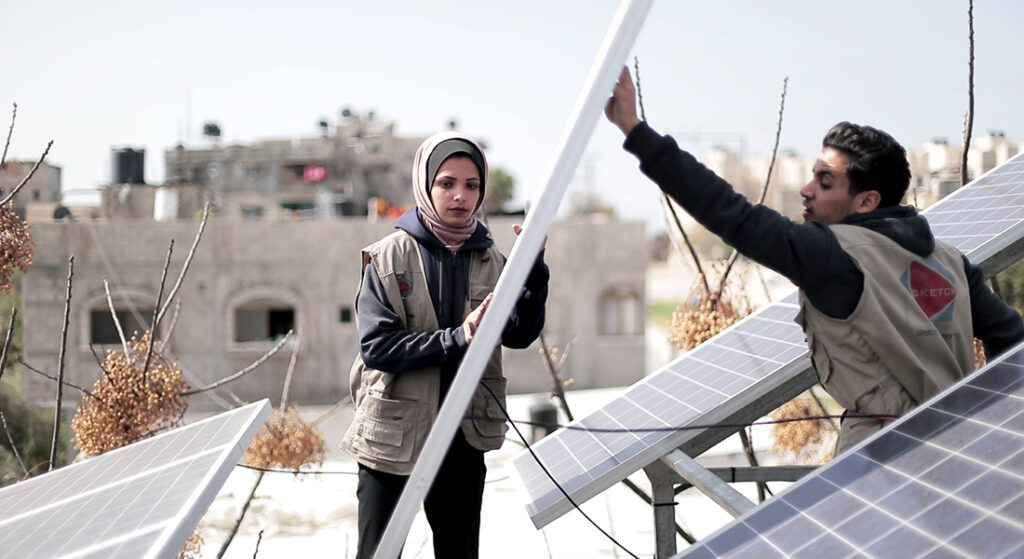
Dreaming to liberate Palestine
Palestinian eco-resistance currently exists under Israel’s occupation and genocide. But the horrors that Israel is perpetrating can’t prevent us from still dreaming of a future where Palestine is free – one where Palestinians have sovereignty over the land without replicating the systems of colonial domination and oppression that are foundational to the capitalist nation-state. This requires not only Palestinian self-determination and return, but also a just transition to an economy that protects workers and centers their needs as essential to ecological transformation.
Manal Shqair identifies five elements that are necessary for a just transition in Palestine:
“First, rejection of the systematically constructed inferiority of Palestinians to their colonizers in terms of knowledge and culture, which is a prerequisite for anti-colonial transformation[…] In this sense, eco-sumud is significant as a counter-narrative to Israeli greenwashing, which, as highlighted above, seeks to legitimize and naturalize Israeli settler colonial dispossession and violence. Second, the relationship with the land and its natural resources should be based on reciprocity and interdependence. Third, land, water and knowledge should be collectively shared, rather than monopolized and commodified as a luxury for the few. Fourth, women are primary rather than secondary actors in the anti-colonial struggle for sovereignty and self-determination. Finally, practicing eco-sumud is ingrained in a belief in the possibility of defeating Israeli settler colonialism, and in the invincibility of the burning desire of the colonized to determine their own destiny.” (p. 82)
We cannot immediately assume these goals are unachievable, because while Palestinians continue to resist occupation, colonialism, and genocide in every part of their lives, the just thing for the rest of us to do is support them wholeheartedly. This is true in all of our fights against oppressoin: if we limit our vision to only what we currently think is possible, we are cutting ourselves off from creative pathways for a more just future. We owe Palestinians – and oursevles – our hope and solidarity for liberation.
While this is the “end” of my current series on climate injustice and Palestine, I still very much plan to keep talking about Palestine in this newsletter. The next few posts that I have planned will likely be less structured essays than what I’ve shared so far, but my inital thoughts are to talk about the fight for Palestinian liberation in the context of international relations, and also how sports intersect with climate change, the fight for Black liberation, and solidarity with Palestine. I also may not stick to a weekly update schedule – we’ll see how it goes.
In the meantime, if you want to learn more about genocide, climate injustice, and eco-colonialism in Palestine, I wanted to share some of the sources that I found most interesting and helpful! You can find them below the mutual aid request.
Mutual Aid Request
This newsletter will never be monetized, but I believe that mutual aid is one of the ways we can build community and support the folks who need it the most. If you like my writing, please consider giving; even just a few dollars (or whatever currency you’re paying in) can help.

Malak Haw, a freelance journalist and university student, needs help getting his family out of Gaza, where their home in northern Gaza was destroyed. They’ve been displaced to southern Gaza for many months, where they lack sufficient access to food and his mother’s medications. Please help Malak and his family escape genocide.
Recommended reading
Environmental Warfare in Gaza, by Shourideh C. Molavi: If you read just one thing out of my recommendations, make it this book. Political scientist and human rights scholar Shourideh C. Molavi began her research for this book with Forensic Architecture to explore the disappearance of Gaza’s orange groves, but her work expanded in the field to uncover the dimensions of Israel’s herbicidal warfare at the Gaza-Israel border. The book is short and relatively easy for a lay audience to read, but despite its brevity, it manages to encompass many different dimensions of the horrors of Israel’s occupation and ecocide.
“Climate Change, the Occupation, and a Vulnerable Palestine”, by Zena Agha for Al-Shabaka: This policy brief outlines the ways Palestinians cannot build resilience climate change without self-determination, describing the risks to Palestinian agriculture, access to water, and other areas of climate vulnerability, as well as highlighting the inability of the Palestinian Authority to plan for climate adaptation.
“The Right of Return: The Only Future for Palestine”, by Salman Abu-Sitta: While this is not strictly about environmental resistance, it’s a crucial read: Nakba expert and engineer Salman Abu-Sitta’s work goes through the history of Zionist land theft, while proving that Palestinian land sovereignty and return to their homes is extremely feasible.
“The Sun Belongs to Everyone: Israeli Demolitions and Confiscations of Solar Panel Aid Projects in Area C of the West Bank”, by Crystal Yeung for Al-Haq: A report on the energy injustice Palestinians face and Israel’s destruction of any attempts at Palestinian solar energy development.
“Impact of Israeli military activities on the environment”, by Mazin B. Qumsiyeh: A succinct but comprehensive accounting of the environmental injustices perpetrated by Israel’s military and how they harm Palestinians and the land.
“Oppressive pines: Uprooting Israeli green colonialism and implanting Palestinian A’wna”, by Ghada Sasa: Political scientist Ghada Sasa analyzes Israel’s eco-colonialist justifications for occupying and perpetrating genocide on Palestinians, including through the planting of pine trees in what Sasa identifies as “green colonies”, and also describes the concepts of a’wna, and a’wda that I covered in this post.
“Environmentalism of the Occupied: A slow violence perspective on the West Bank’s deteriorating agricultural sector, and an overview of Palestinian agro-resistance in the struggle towards food sovereignty”, by J. L. Pedersen: This Master’s Thesis by human ecologist J.L. Pedersen, based on her fieldwork in the West Bank, sets context for Palestinian agro-resistance and the fight for food sovereignty, and offers a number of illuminating examples that I didn’t have space to include in this post.
Dismantling Green Colonialism: Energy and Climate Justice in the Arab Region, edited by Hamza Hamouchene and Katie Sandwell: This 2023 collection is one that I would recommend more for energy policy nerds than for folks new to climate justice issues, but it’s definitely worth the read! I bought it specifically to check out climate researcher Manal Shqair’s piece that I have quoted from throughout this series, but all of the chapters are fascinating, and I learned a lot about the ways that colonialism still impacts energy monopolies and neoliberalism in the energy sector in much of southwest Asia and north Africa. In addition to Shqair’s chapter on energy injustice in Palestine and the Jawlan, I also particularly liked the chapter by Joanna Allan, Hamza Lakhal, and Mahmoud Lemaadel on extractivism and Morocco’s occupation of Western Sahara, as well as Asmaa Mohammed Amin’s chapter on the energy sector in Jordan, which also goes into Israel’s attempts at energy normalization with Jordan and the harmful impacts to Jordanians and their renewable energy industry.


